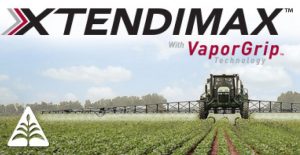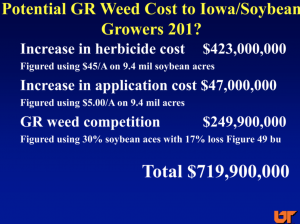Dr. Larry Steckel, a weed scientist from Tennessee with 30+ years experience working with farmers on pesticide issues, has written a thoughtful piece in the Delta Farm Press about the ongoing dicamba-drift crisis.
Steckel is quoted in our Dicamba Watch dynamic presentation and has been an important voice throughout this crisis, now in its third year. The ongoing damage from drifting dicamba is “like nothing I have ever seen before,” he says.
Dicamba-resistant soybeans were deregulated (approved) by the USDA in 2016, but throughout crop season 2016, the EPA failed to approve the herbicide-product labels allowing, for the first time, over-the-top of the crop, post-emergent applications of dicamba on soybeans and cotton.
This resulted in illegal dicamba applications throughout the late spring and summer of 2016, and led to damage to several million acres of crops in the vicinity of illegally sprayed Extend fields. EPA approved several new, Monsanto, BASF, and DuPont post-emergence herbicide labels for glyphosate+dicamba applications on soybeans and cotton prior to the 2017 crop season.
In 2016 and since, volatilization-driven drift and crop damage has been most severe during the hot and steamy summer days, especially when there is a weather inversion.
Dicamba is a highly volatile herbicide, but Monsanto and BASF assured regulators that their new dicamba+glyphosate formulations would be much less prone to volitilization and drift. As damage reports mounted each year, Monsanto consistently insisted the cause was “applicator error” and that if properly applied according to all label requirements, their new herbicides would stay put.
But according to Steckel “following (the label instructions) as they are now is a Herculean task” and almost impossible to achieve across thousands of acres (Gray, 2017).

In his new opinion piece in Delta Farm Press, Steckel praises the current efforts of applicators to follow the new dicamba restrictions put in place by EPA for the 2018 season, saying that “most took the dicamba stewardship training to heart and…they have really done as good a job as possible.”
In other words, Monsanto’s claim that applicators are at fault just “does not wash” with what Larry Steckel sees every day in the fields of Tennessee.
Steckel also makes the important point that the main reason dicamba soybean damage seems to be down this year may have little to do with efforts to control drift. Instead, there is less damage this year because most soybean acres are now planted to Extend, dicamba-resistant varieties. Hence, the acreage of soybeans vulnerable to dicamba-drift damage is much lower than in 2017.
Most farmers in Tennessee have made the switch to the new Xtend soybeans. Steckel estimates that only about 100,000 acres remain in Tennessee of non-dicamba resistant soybeans, and about 40% of those are showing damage from dicamba.
—Larry Steckel, Extension Weed Specialist, University of Tennessee
Steckel closes by pondering whether the “new sheriff in town,” Bayer, will “change course before [their] credibility is damaged beyond the point of no return.” We shared our own musings on whether Bayer is likely to shake things up after it’s purchase of Monsanto earlier this year.
For over a decade Larry Steckel has been on the front lines of dealing with the rapid spread of glyphosate-resistant weeds in Tennessee and elsewhere in the Southeastern U.S. In recent years, Steckel has made the rounds in the Midwest during the winter season, making invited presentations at dozens of farmer meetings. His message has been straightforward — aggressive steps must be taken immediately to contain the spread of resistant weeds, because in their absence, grower expenditures on herbicides will skyrocket and control failures will become much more common.
His 2012 presentation to a meeting of Iowa soybean growers was entitled “Glyphosate-Resistant Weeds: Lessons Learned in Tennessee.” He estimated that Iowa soybean farmers could see their ANNUAL herbicide costs rise $423,000,000 ($45/acre, 9.3 million acres), coupled with a loss of $249,000,000 in yield from weed competition (average 17% yield loss on 30% of acres), if glyphosate-resistant weeds become as common in the Midwest as they are now in the Southeast.

Another $47 million would be spent on additional herbicide applications, for a statewide, soybean industry total cost of $719.9 million.
In crop year 2018, Iowa soybean farmers are likely to spend several hundred million more dollars on seed+herbicides compared to 2015, and experience as yet unknown yield reductions from dicamba and other herbicide drift damage. Such sharply rising grower costs are contributing to higher per bushel production costs that now threaten to render Midwest soybean production uncompetitive in world markets, except in years when weather-constrained yields push market prices well above trend lines.
Both in his 2012 presentation and this new op-ed, Steckel also warns of other dangers for the agricultural community if farmers and the industry continue down the road of more post-emergence herbicide applications and multi-herbicide-resistant crops. He and others speculate that dicamba damage to trees, specialty crops, backyard gardens, school grounds, and public spaces may eclipse crop damage, causing suburban and urban communities to pay closer attention to what is going on down on the farm.
For much more coverage of the unfolding dicamba drift crisis, see the Dicamba Watch bibliography
Sources:
Bryce Gray, “Class lawsuit takes aim at dicamba producers, accuses Monsanto reps of condoning illegal spraying,” St. Louis Post-Dispatch, July 23, 2017.
Larry Steckel, “Dicamba drift problems not an aberration,” Delta Farm Press, August 8, 2018.

